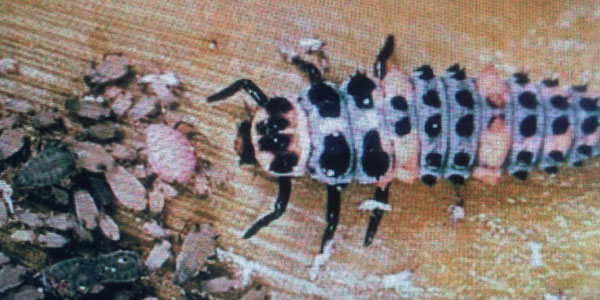
Integrated Pest Management
A new approach to pest control of plants has been tested and found to be very effective in not only controlling pests, but also in greatly reducing the need for the application of chemicals.
The key to an effective integrated pest management (IPM) program is regular monitoring to detect the pest when it first becomes active. This is done through regular inspection of plants by specialists and by using traps or other collection devices to spot the first few pests on the scene. Action is taken immediately, before the number of pests has a chance to increase.
The first control used should be non-chemical such as hand collecting of pests and pruning out infected or diseased limbs or plants. Next, a biological control system is considered and used if deemed adequate. Lastly, chemicals are used. Treatment should be early when only a small area is affected, spraying only infected plants, thus reducing the need to spray entire fields or other large areas. Often, one well-timed spray application on a small area is all that is needed for control the entire season. The least toxic chemicals available should be used first. Spray oils, which are now highly refined and effective, are very safe for the plant. If used early in the season, spray oils may eliminate the need to spray with more toxic chemicals later, thus protecting the environment.
The Need for Biological Control
The most exciting thing about this success in biological pest control is that we are finally looking to nature for control of plant pests rather than using highly poisonous chemical materials. Many of these chemicals are no longer effective anyway, because insects become resistant to them. The Chinese use biological control to a very large extent and we can learn much from them in this respect.
Despite close monitoring, new plant pests and weeds are still being introduced into the United States. It is now estimated that 11 new immigrant species make the United States their home each year and that about 7 of these will become “pests of some importance.” Bringing in the natural enemies of these new pests will be important in controlling them. Nature normally has a system of balances in which each creature, large and small, has some natural enemy to help control the population. It is easy to understand how a new insect, weed, or disease, introduced in an area where there are no natural enemies, would multiply rapidly.
A HERBICIDE is a chemical that kills weeds.
A weed is considered to be any plant growing where it is not wanted. Grass that is growing in a lawn is not a weed but is considered a weed if it is growing in the garden.
Types of Herbicides
Nonselective Herbicides
Nonselective herbicides kill all plants to which they are applied. These herbicides are used in places where no plant growth is wanted. Lumber yards, railroad tracks, fence lines, driveways, and parking areas are a few examples of areas where these chemicals are used. An example of a weed killer in this category is Roundup.
Selective herbicides are just what the name implies—chemicals that kill some plants but not others. In some cases, a selective weed killer that kills broadleaf plants will not kill grasses, which have narrow, bladelike leaves. This makes it possible to spray a lawn to kill dandelions, which have a broad leaf, and not kill the grasses.
Weed killers, herbicides, work in many ways and on various plants. It is very important to select the proper chemical and apply it properly. A new biocontrol herbicide has been discovered that is very effective against broadleaf weeds. Always read the label to determine the proper use of the herbicide.
____________________________
Contact us today and Experience the Different Services, Our work Quality and Our Values
For all your Landscaping Needs.
Free estimates, Honest & Affordable
Give us a call or Email us at
marioperez@amlandscapeinlasvegas.com
office: 702-832-6293
Mario Perez Cell: 702-410-3678
____________________________